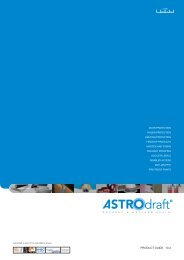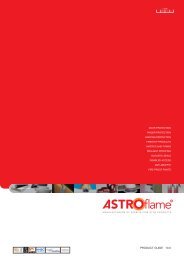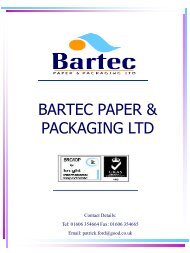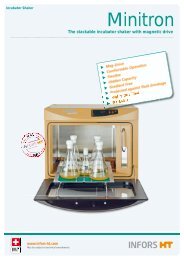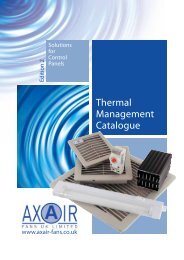Fastening & Assembly Solutions & Technology July 2012
Fastening & Assembly Solutions & Technology July 2012
Fastening & Assembly Solutions & Technology July 2012
Create successful ePaper yourself
Turn your PDF publications into a flip-book with our unique Google optimized e-Paper software.
FAST JULY <strong>2012</strong><br />
ADHESIVE FORMULATION<br />
Speciality building blocks<br />
for adhesive formulators<br />
The key to success in helping the formulators of adhesive or composite solutions to achieve market<br />
differentiation is based on producing speciality chemical building blocks that meet customer’s<br />
expectations. FAST explains how specialist materials manufacturer Huntsman has achieved this by<br />
focusing on a four-pronged approach based on performance enhancement, cost reduction,<br />
formulation processing optimisation and limitation of toxic substances<br />
Huntsman Advanced Materials relies<br />
on a four-pronged approach to the<br />
building blocks it manufactures to formulate<br />
modern adhesives. This approach is<br />
predicated on performance enhancement,<br />
cost reduction, formulation processing<br />
optimisation and the limitation of toxic<br />
substances wherever possible.<br />
Huntsman’s core competencies lie in<br />
synthesis and formulation and the company<br />
utilises these skills to add new and<br />
innovative high performance materials to<br />
its range of proven and qualified building<br />
blocks in the drive to enable market differentiation<br />
for formulators in the areas of<br />
adhesives and composites, focused on the<br />
delivery of mechanical and thermal performance<br />
improvement.<br />
Take resins and hardeners, for example:<br />
TGMAP type Araldite MY0610<br />
offers very high mechanical and thermal<br />
properties. In comparison to TGMDA<br />
resins, such as Araldite MY 721, higher<br />
modulus can be achieved with similar<br />
thermal resistance (see figure 1).<br />
Another example is tri-functional,<br />
TGHPM type epoxy resin Tactix 742 provides<br />
higher glass transition temperature<br />
resistance than any other resin.<br />
Dycyclopentadiene based, novolac<br />
epoxy Tactix 556 presents the lowest<br />
moisture absorption among any other<br />
epoxy resin (see figure 2) but diaminodiphenylsulfone<br />
hardener Aradur 976<br />
offers thermal resistance and stability, as<br />
well as chemical resistance.<br />
Tougheners and flexibilisers<br />
Specially modified epoxy/rubber adduct<br />
Araldite LY 1146 improves impact resistance,<br />
adhesion on contaminated surfaces<br />
and corrosion resistance. While working<br />
at higher temperature than epoxy/rubber<br />
adducts, Flexibiliser DY 965 provides<br />
32<br />
good impact resistance<br />
and adhesion to metal (see<br />
figure 3)<br />
Other resins including benzoxazines,<br />
such as Araldite<br />
MT35600, are a special class<br />
of thermosets, exhibiting<br />
extremely good thermal and<br />
mechanical properties while<br />
Kerimid and Matrimid polyimide<br />
resins are a range of<br />
polyimide and bismaleimide<br />
resins suitable for long term<br />
resistance above 200°C.<br />
Reducing formulation<br />
costs<br />
While reducing the cost of<br />
formulations can be achieved<br />
through the careful selection<br />
of raw materials, the manufacturing<br />
process is also pivotal<br />
to the delivery of sustainable<br />
solutions. Reducing the number<br />
of mixing or synthesis<br />
operations, lowering production<br />
time through easier incorporation<br />
and reducing the<br />
investment in manufacturing<br />
equipment are all examples of<br />
the factors that strongly influence<br />
the final cost of a formulation.<br />
With access to a number of<br />
complementary global production<br />
facilities, the company<br />
offers off-the-shelf or customised,<br />
high quality and cost<br />
effective products and services<br />
for formulators within<br />
blends (of resins or hardeners),<br />
master-batches, as well<br />
as pre-adducted chemicals.<br />
Blends of liquid bisphenol A based<br />
Figure 1: Comparing the modulus that can be achieved<br />
with similar thermal resistance<br />
Figure 2: Moisture absorption among epoxy resin<br />
Figure 3: Studying impact resistance and adhesion<br />
to metal surfaces<br />
epoxy resins with reactive diluents, such<br />
as Araldite BY 158 or Araldite BY 157, or<br />
blends of solid bisphenol A epoxy resins



